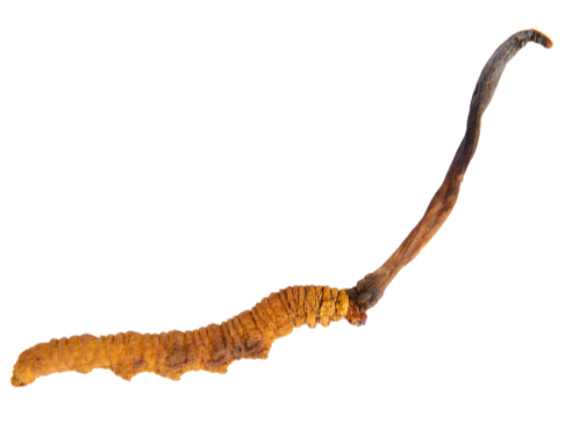The disturbing secret behind Cordyceps Mushroom
- Hailey Mae
- Feb 12, 2023
- 3 min read

So far, over 700 species of Cordyceps mushrooms have been identified, most of which originate in Asian countries. Two in particular Cordyceps sinensis and Cordyceps militaris—are highlighted for their medicinal properties; others are being investigated for potential benefits.
Identification & Harvest
Cordyceps mushrooms, as the name implies, grow in long, spindly forms with a little "club" at the top. They might be brown or brilliant orange in color and are distinct from other mushrooms. Most mushrooms grow on dead trees or rotting debris, while Cordyceps likes to grow on insects. It is classified as an endoparasitoid or entomopathogenic fungus, and its preferred hosts are anthropods, certain types of bug and other invertebrates with exoskeletons, the most common of which are Ghost moth larvae. Cordyceps spores enter the body of a ghost moth larva and consume its internal tissues as fuel. The Himalayan highlands are a popular collecting destination since wild cordyceps are mostly found at higher elevations—between 3,500 and 5,000 meters (11,500 to 16,400 feet).
Cordyceps (Cordyceps Sinensis)
Region: Tibetan Plateau (also China, Nepal, Tibet, and India.)
Season: May through August
Habitat: BUGS, anthropods to be exact—bugs and other invertebrates with exoskeletons
Size: 3-5cm
Shape: Spindly shapes with a small “club” at the top
Color: Orange, Golden
Notes: Most supplements are not made with this species as they are over harvested, threatened and hard to find being that they can not be cultivated commercially unlike the Militaris species.

Cordyceps (Cordyceps Militaris)
Season: all year
Habitat: Lab grown, in mushroom spawn
Size: 3-5cm
Shape: Spindly shapes with a small “club” at the top
Color: Slightly more pale Orange, Orange, Golden
Notes: Traditional used in supplements over the Sinensis species as it can be commercially cultivated. It also contains 90 times more health-supporting cordycepin than the Sinensis.
Common health benefits of Red Belted Polypore Mushroom
Immune System Support
The most famous polysaccharides present are beta-glucans, which are frequently noted for their capacity to regulate and boost immunological function. Cordyceps' beta-glucan content most likely plays a role in the mushroom's multiple immune-boosting properties.
The fascinating thing about cordyceps is that it is not necessarily an immune "booster," but rather an immune modulator, are many medicinal mushrooms, since it either stimulates or suppresses immune responses based on what the body requires. Cordyceps' actions may boost the body's ability to kill invading germs and viruses, as well as destroy and eliminate damaged cells. Cordyceps may also benefit the health and function of the kidneys, spleen, and thymus, all of which play important roles in immunity. They have even been shown to activate Macrophage, which increases the body’s ability to get rid of pathogens, also aiding in immune support.
Anti-Aging
Cordyceps has anti-inflammatory and antioxidant activities, which suggests that it might be an excellent choice for supporting healthy lifespan and slow the effects of aging. Cordyceps has been shown in one research to increase oxygen absorption, aerobic capacity, fatigue resistance, better memory, and brain function. What may be the mechanism? A decrease in monoamine oxidase (MAO), which is responsible for the breakdown of neurotransmitters used by brain cells to communicate.
Terms to Know
Free Radicals: an uncharged molecule (typically highly reactive and short-lived) having an unpairedvalence electron.
Macrophages: a large phagocytic cell found in stationary form in the tissues or as a mobile white blood cell, especially at sites of infection. Critical for innate immunity, normal tissue development, homeostasis, and repair of damaged tissue.
Anti-inflammatory
Cordycepin and other compounds in cordyceps mushrooms exhibit anti-inflammatory properties. Cordcyeps’ anti-inflammatory effect is one of the reasons this mushroom is beneficial for immunity. Reducing inflammation helps restore balance in the immune system, allowing for more effective and appropriate responses to pathogens. Less inflammation can also mean less pain, making cordyceps a potential option for pain relief.
Antioxidant
Cell damage caused by oxidative stress can lead to inflammation, yet cordyceps shows promise as an antioxidant. Extracts not only lower the amount of free radicals that cause oxidative damage, but they may also prevent cholesterol from oxidizing, which is the initial step in the formation of plaques in blood vessels.
Cordyceps polysaccharides and polyphenols appear to have the strongest antioxidant potential. The severity of the reaction to oxidative stress varies based on the cordyceps variety and chemical type.
Resources
Shields, Tony. “What Are Cordyceps Mushrooms? This Guide Tells All! - FreshCap Mushrooms.” Growing, https://learn.freshcap.com/tips/cordyceps-guide/. Accessed 12 February 2023.






Comments